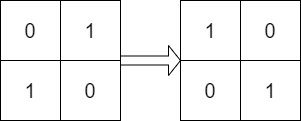LeetCode-in-Java
1886. Determine Whether Matrix Can Be Obtained By Rotation
Easy
Given two n x n binary matrices mat and target, return true if it is possible to make mat equal to target by rotating mat in 90-degree increments, or false otherwise.
Example 1:

Input: mat = [[0,1],[1,0]], target = [[1,0],[0,1]]
Output: true
Explanation: We can rotate mat 90 degrees clockwise to make mat equal target.
Example 2:

Input: mat = [[0,1],[1,1]], target = [[1,0],[0,1]]
Output: false
Explanation: It is impossible to make mat equal to target by rotating mat.
Example 3:

Input: mat = [[0,0,0],[0,1,0],[1,1,1]], target = [[1,1,1],[0,1,0],[0,0,0]]
Output: true
Explanation: We can rotate mat 90 degrees clockwise two times to make mat equal target.
Constraints:
n == mat.length == target.lengthn == mat[i].length == target[i].length1 <= n <= 10mat[i][j]andtarget[i][j]are either0or1.
Solution
import java.util.Arrays;
public class Solution {
public boolean findRotation(int[][] mat, int[][] target) {
for (int i = 0; i < 4; i++) {
if (Arrays.deepEquals(mat, target)) {
return true;
}
rotate(mat);
}
return false;
}
private void rotate(int[][] mat) {
// Reverse Rows
for (int i = 0, j = mat.length - 1; i < j; i++, j--) {
int[] tempRow = mat[i];
mat[i] = mat[j];
mat[j] = tempRow;
}
// Transpose
for (int i = 0; i < mat.length; i++) {
for (int j = i + 1; j < mat.length; j++) {
int temp = mat[i][j];
mat[i][j] = mat[j][i];
mat[j][i] = temp;
}
}
}
}

